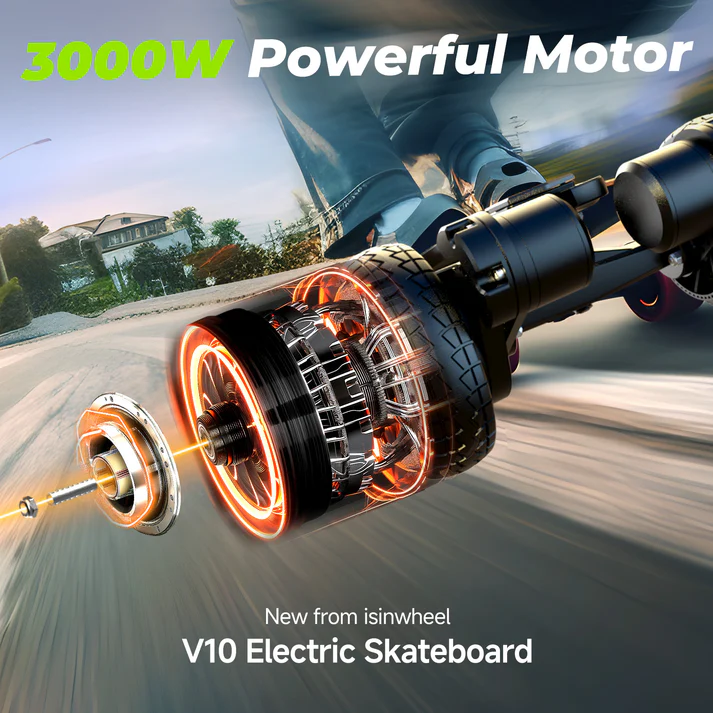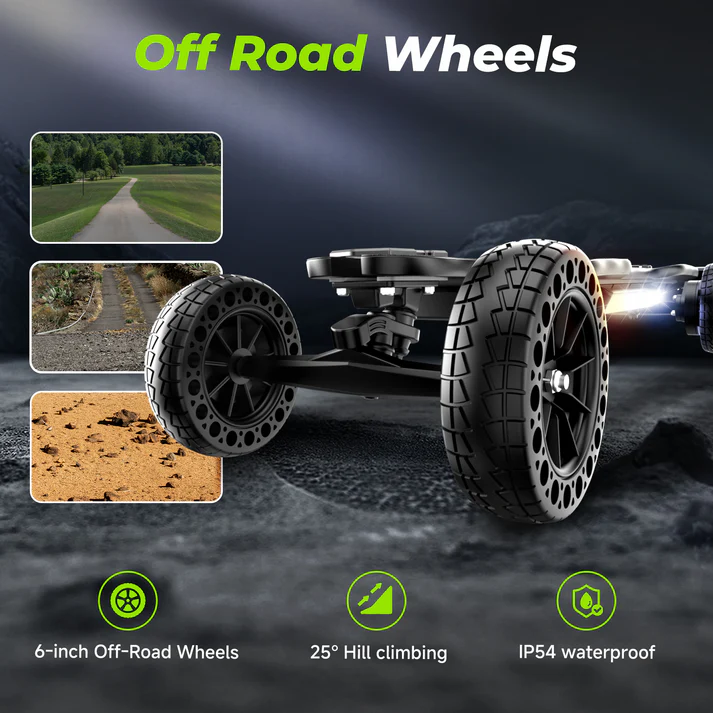What is an electric skateboard?
An electric skateboard is a type of skateboard powered by an electric motor. Unlike traditional skateboards, which rely solely on the rider’s physical pushing and kicking, electric skateboards have a battery-powered motor that propels the rider forward. This motor allows riders to achieve higher speeds and navigate different terrains more easily than a regular skateboard.
Electric skateboards typically consist of a deck, trucks, wheels, and a motorized drivetrain. The motor is usually located in the rear of the skateboard and provides the necessary power to move the board forward. A handheld remote controls it, allowing the rider to accelerate, decelerate, and maintain speed.
One of the main advantages of electric skateboards is their ability to tackle inclines and downhill slopes easily. The motor provides extra power to overcome gravity and maintain a smooth, controlled speed while going downhill. This makes electric skateboards appealing to riders who enjoy the thrill of downhill rides or commuting in hilly areas.
Electric skateboards are designed with the capability to handle various terrains such as off road skateboard, making them suitable for both flat surfaces and downhill slopes. The motorized drivetrain works with the rider’s body movements, ensuring a smooth and controlled descent.
How do electric skateboards work?
Electric skateboards use an electric motor and a battery to propel the rider forward. When the rider accelerates using the handheld remote control, a signal is sent to the motor, which turns on and begins spinning the wheels. This motorized drivetrain allows the rider to achieve higher speeds than possible with their physical effort.

Components of an electric skateboard
Electric remote control skateboard are composed of several key components that work together to provide a smooth and efficient ride. These components include:
- Deck: The deck is the main platform of the skateboard where the rider stands. It is usually made of a durable and lightweight material, such as wood or carbon fiber, to provide stability and flexibility.
- Motor: The motor is the heart of the electric skateboard. It converts electrical energy from the battery into mechanical energy to power the wheels. Electric skateboards typically use brushless motors, which are more efficient and reliable than brushed motors.
- Battery: The battery provides power to the motor. Electric skateboards use rechargeable lithium-ion batteries, which balance energy density and weight well. The battery capacity determines the skateboard’s range, with higher-capacity batteries allowing longer rides.
- Motor Controller: The motor controller interfaces the rider and the electric skateboard. It receives inputs from the handheld remote control and translates them into signals that regulate the speed and acceleration of the motor.
- Wheels: Electric skateboards have wheels specifically designed to provide a smooth and stable ride. They come in various sizes and hardness levels. Larger and softer wheels provide better shock absorption and grip, while smaller and harder wheels offer increased maneuverability and speed.
How electric skateboards are powered
One of the most important components of an electric skateboard is the battery. The battery stores the electrical energy needed to power the motor and propel the rider forward. Electric skateboards typically use rechargeable lithium-ion batteries due to their high energy density and lightweight properties.
The battery capacity determines the skateboard’s range, with larger batteries allowing longer rides. Riders should consider the battery range and choose one that suits their needs. Some electric skateboards also have regenerative braking, which means the battery charges when the rider brakes or goes downhill, increasing the overall range.
To recharge the battery, riders simply plug the charger into an electrical outlet and connect it to the skateboard’s charging port. Charging times vary depending on the battery capacity and charger specifications. It is essential to follow the manufacturer’s guidelines on battery charging to ensure longevity and safety.
It’s worth noting that the battery life of an electric skateboard can vary depending on factors such as speed, terrain, and rider weight. Riding at higher speeds or on hilly terrain can drain the battery faster than riding on flat surfaces at moderate speeds.
The motor controller is another crucial component that plays a significant role in powering the electric skateboard. It receives signals from the handheld remote control and translates them into signals that regulate the speed and acceleration of the motor. It acts as the brain of the electric skateboard, ensuring smooth and responsive performance.
Benefits of electric skateboards
In addition to the motor controller, electric skateboards offer a range of benefits that make them a popular choice among riders of all skill levels. Here are some of the key advantages of electric skateboards:
- Speed and Acceleration: Electric skateboards can reach higher speeds than traditional skateboards, thanks to the power provided by the electric motor. With a button push or a slight tilt of the handheld remote control, riders can experience exhilarating acceleration and enjoy cruising at impressive speeds.
- Hill Climbing Ability: One of the standout features of electric skateboards is their ability to tackle uphill terrains easily. The powerful electric motor provides enough torque to conquer steep inclines, allowing riders to enjoy the thrill of downhill riding without pushing or foot braking.
- Extended Range: Unlike traditional skateboards that rely solely on the rider’s physical exertion, electric skateboards can cover longer distances. With larger battery capacities, riders can enjoy rides of several miles before recharging. This makes electric skateboards a convenient mode of transportation for short commutes or exploring the city.
- Customizable Speed Modes: Electric skateboards often come with multiple speed modes, allowing riders to choose their preferred level of performance and control. Beginners can start with slower speeds to build their confidence and gradually increase their speed as they become more comfortable. On the other hand, experienced riders can enjoy the excitement of higher speeds and push the limits of their electric skateboards.
Can electric skateboards go downhill?
Yes, electric skateboards are designed to handle downhill riding with ease. The powerful electric motor provides the necessary speed and control to navigate downhill terrains safely and efficiently. Here are a few reasons why off road electric skateboard are well-equipped for downhill riding:
- Regenerative braking: Electric skateboards have regenerative braking systems that convert the kinetic energy generated downhill into electrical energy. This not only helps to slow down the skateboard but also charges the battery in the process. Regenerative braking ensures better control and stability while descending steep hills, giving riders a smoother and more controlled downhill experience.
- Responsive motor control: The motor controller in electric skateboards allows for precise and responsive control, making it easier for riders to adjust their speed and maintain balance while going downhill. With the handheld remote control, riders can gradually slow down or accelerate as needed, giving them greater control over their riding experience.
- Enhanced stability: Electric skateboards often have wider decks and larger wheels than traditional skateboards, improving stability during downhill rides. The increased width of the deck allows riders to maintain a centered stance, while larger wheels offer better grip and traction on various types of surfaces. These features contribute to a smoother downhill experience, as riders can maintain stability and balance even on uneven or bumpy surfaces.
Factors to consider when going downhill on an electric skateboard
When going downhill on an electric skateboard, there are several factors that riders should consider to ensure a safe and enjoyable experience. These factors include:
- Speed control: Downhill riding can quickly accelerate the speed of an electric skateboard. Riders must have a good grasp of their speed control capabilities and be able to regulate their speed effectively. Gradually increasing or decreasing speed using the handheld remote control is crucial to maintaining balance and avoiding accidents.
- Hill gradient: The gradient of the hill or slope can impact how fast the electric skateboard accelerates. Steeper slopes will generate more speed, while gentler slopes may require more effort to maintain momentum. Riders should choose hills that match their skill level and feel comfortable navigating based on their board’s capabilities.
- Trail conditions: Another important factor to consider is the condition of the trail or road surface. Smooth and well-paved surfaces provide better traction and stability for downhill riding. Riders should be cautious of loose gravel, potholes, or other obstacles that could cause accidents or make it difficult to control the board.
- Body positioning: Proper body positioning is essential for maintaining balance and control while going downhill on an electric skateboard. Keeping the weight centered over the board and having knees bent and slightly crouched can help absorb any bumps or changes in terrain, allowing for better control and stability. The upper body should be relaxed, and the arms should be slightly bent for balance and maneuverability.

Speed control and braking mechanisms
Speed control is crucial when going downhill on an electric skateboard. Most electric skateboards come equipped with handheld remote controls that allow riders to adjust their speed. By gradually increasing or decreasing the speed, riders can maintain control and avoid sudden jolts or loss of balance.
Some electric skateboards also offer regenerative braking, which allows the rider to slow down or come to a complete stop by simply easing off the throttle. This feature helps riders maintain control while going downhill and conserves battery life by converting the energy generated during braking into power for the board.
In addition to the remote control, some electric skateboards have built-in braking mechanisms, such as a foot brake or electronic brakes. These mechanisms provide extra power and safety, allowing riders to slow down or stop quickly when needed.
Riders should familiarize themselves with their electric skateboard’s speed control and braking mechanisms. Practicing on flatter surfaces or gentle slopes can help riders get a feel for their board’s responsiveness and braking capabilities before attempting more challenging downhill rides.
Safety precautions when going downhill on an electric skateboard
- Wear protective gear: When going downhill on an electric skateboard, it is vital to prioritize safety and wear proper protective gear. This includes a helmet to protect the head from potential falls or collisions. Additionally, riders should consider wearing knee pads, elbow pads, and wrist guards to protect their limbs in case of accidents. Wearing the right gear can minimize the risk of injuries and provide peace of mind while riding downhill.
- Choose the right path: Before heading downhill, assessing the path and choosing a route suitable for electric skateboarding is important. Look for roads or trails with smooth pavement and minimal traffic, which provide a safer environment for downhill riding. Avoid roads with steep gradients or excessive traffic, as these factors can increase the likelihood of accidents or collisions. It is also essential to be aware of local regulations regarding electric skateboarding and adhere to any speed limits or usage restrictions.
- Maintain a safe distance: When riding downhill, give yourself enough space to react to unforeseen obstacles or sudden changes in the terrain. Leave a safe distance between yourself and any vehicles, pedestrians, or cyclists sharing the road. This will allow you to brake or maneuver safely if needed. Remember that electric skateboards have a shorter stopping distance than traditional ones, so leaving ample space for sudden stops or maneuvers is crucial.
Tips for going downhill on an electric skateboard
- Start slow: When going downhill on an electric skateboard, it’s best to start at a slower speed and gradually increase your velocity as you gain confidence and become more comfortable with the board’s handling. This allows you to maintain better control and react more effectively to any obstacles or changes in terrain.
- Stay balanced: Keeping a balanced stance on your electric skateboard is crucial when going downhill. Distribute your weight evenly over the board, keeping your knees slightly bent and your body centered. This helps you maintain stability and control as you navigate the descent.
- Use your body to control speed: While electric skateboards typically have speed control settings, you can also use your body to regulate your speed when going downhill. Leaning forward slightly can increase your speed while leaning backward can slow you down. It’s important to remember that sudden shifts in weight distribution can lead to loss of control, so make any adjustments gradual and smooth.
- Brake steadily: Electric skateboards are equipped with a braking system that enables riders to gradually reduce speed or bring the board to a complete halt. Braking steadily rather than abruptly when descending a downhill slope is crucial. Apply gentle pressure to the brakes, allowing yourself enough time and distance to come to a safe stop. Sudden or harsh braking can lead to loss of control and potential accidents.
- Stay alert and scan the road ahead: Going downhill on an electric skateboard requires a heightened awareness of your surroundings. Look for potential hazards, such as potholes, debris, or uneven surfaces, and plan your route accordingly. Keeping your eyes focused on the road ahead allows you to react quickly and make necessary adjustments to avoid accidents or collisions.
Choosing the right speed and mode
When choosing the right speed and mode for going downhill on an electric skateboard, consider your skill level, the terrain, and comfort level. Most electric skateboards have different speed modes or settings that riders can choose from. These modes determine the maximum speed the board can reach and can often be adjusted according to the rider’s skill level.
Starting with a lower-speed mode is recommended for beginners or riders who need to be fully confident in their downhill skills. This allows for better control and a more gradual learning curve. As they become more experienced and comfortable, they can gradually increase the speed setting to go faster downhill.
Paying attention to the terrain you will be riding on is also crucial. Steep hills or uneven surfaces may require you to adjust the speed accordingly. It’s always better to err on caution and choose a slower speed when facing challenging downhill sections.
Some electric skateboards also come equipped with braking modes or settings. These settings determine the brakes’ sensitivity and how quickly the board stops when the brakes are applied. Again, it is recommended that beginners start with a less sensitive braking mode and adjust as needed based on their comfort level and the steepness of the downhill slope.
Maintaining balance and stability
Maintaining balance and stability while going downhill on an electric skateboard is crucial for a safe and enjoyable ride. Here are some tips to help you keep your balance and stability:
- Keep a low center of gravity: To maintain stability, keeping your center of gravity low is important. Bend your knees slightly and lower your body closer to the board. This helps you maintain balance and gives you better control over the board.
- Distribute your weight evenly: Distributing your weight evenly on the board will help you maintain stability. Avoid leaning too far forward or backward, which can disrupt your balance. Instead, keep your weight centered over the board by aligning your body with the direction of the slope.
- Use your body to steer: Instead of solely relying on the remote control to change directions, use your body to steer the electric skateboard. Shift your weight and lean into the turns to initiate smooth and controlled maneuvers. This will help you maintain better control and stability while going downhill.
- Keep your feet firmly planted: Make sure that your feet are properly positioned on the skateboard deck, ensuring a wide stance. This will give you a stable base and enhance your ability to control the board. Ensure that your toes point forward and utilize your feet to steer the skateboard for optimal control.
- Stay relaxed and focused: It’s important to stay calm and focused while going downhill on an electric skateboard. Tension in your muscles can throw off your balance and make it harder to control the board. Keep your body loose, and don’t tense up. Stay focused on the path ahead and anticipate any potential obstacles or changes in the terrain.
Proper braking techniques
Proper braking techniques are essential when going downhill on an electric skateboard to ensure a safe and controlled descent. Here are some tips to help you brake effectively:
- Gradually apply the brakes: When initiating the braking process, it’s important to start gradually applying the brakes. Avoid abruptly slamming on the brakes, which can cause the skateboard to skid or throw you off balance. Instead, gently squeeze the brakes, allowing yourself to slow down gradually.
- Use the regenerative braking feature: Many electric skateboards are equipped with regenerative braking, which converts the kinetic energy generated during braking into electrical energy to recharge the battery. This feature improves the skateboard’s efficiency and provides a smoother braking experience. If available, take advantage of this feature by using the regenerative braking mode on your skateboard.
- Pump the brakes: As you descend a steep hill, gently pump them instead of continuously holding them down. This technique helps maintain traction between the wheels and the ground, reducing the risk of skidding or sliding. Pumping the brakes involves repeatedly applying and releasing pressure on the brake, which can be done by squeezing and releasing the brake lever or gradually alternating pressure on the brake pedal.
- Use your body to control the speed: In addition to using the brakes, you can also use your body to control the speed while going downhill on an electric skateboard. One technique is to crouch down into a compact position, which reduces wind resistance and can help you maintain a lower speed. You can also shift your weight towards the back of the board to put more pressure on the rear wheels, providing additional braking power.
Be aware of your surroundings: When going downhill on an electric skateboard, it’s crucial to be mindful of your surroundings. Look for obstacles or hazards in your path, such as potholes, debris, or pedestrians. Knowing and anticipating these potential obstacles will allow you to react quickly and navigate them safely.

